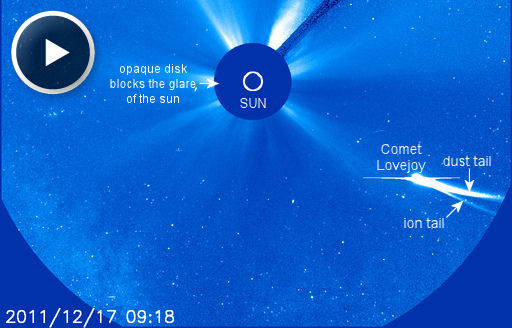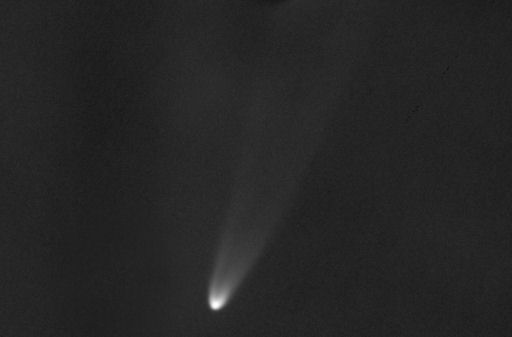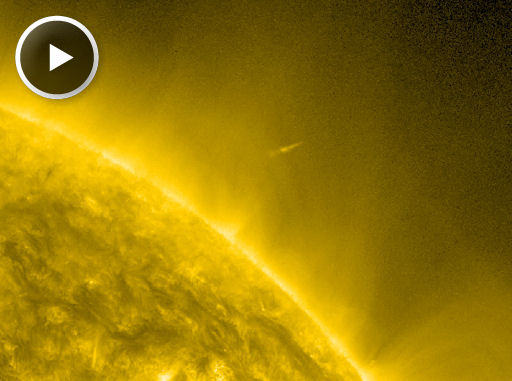Metallic photos of the sun by renowned photographer Greg Piepol bring together the best of art and science. Buy one or a whole set. They make a stellar gift. | | |
QUIET SUN: Solar activity is very low. WIth no sunspots producing strong flares, the sun's x-ray output has flatlined. Significant flares are unlikely this weekend.
CONTINUED ADVENTURES OF COMET LOVEJOY: The scorched core of sungrazing Comet Lovejoy is still intact as it recedes from the sun. Even the comet's flamboyant tail, temporarily lost in transit through the solar corona, has regrown. Click to view the last 24 hours of coronagraph images from the Solar and Heliospheric Observatory (SOHO):

SOHO images show two tails: the ion tail and the dust tail. The ion tail is made of gas and is blown directly away from the sun by the solar wind. The heavier dust tail is curved and more closely traces the comet's orbit.
Now that the comet is more than five degrees from the sun, it is possible (albeit still not easy) for amateur astronomers to photograph it just before sunrise. A team led by Czech astronomer Jan Ebr captured this image at sunrise on Dec. 17th:

Credit: Jakub Cerny, Jan Ebr, Martin Jelinek, Petr Kubanek, Michael Prouza, Michal Ringes
"We used a remotely-controlled 12-inch telescope in Malargue, Argentina," says Ebr. "The sun was below horizon at the time we took the picture, but just barely. There was only a 30 minute window between the rise of the comet and that of the sun "
COMET LOVEJOY SURVIVES: Incredibly, sungrazing Comet Lovejoy survived its close encounter with the sun yesterday. Lovejoy flew only 140,000 km over the stellar surface during the early hours of Dec. 16th. Experts expected the icy sundiver to be destroyed. Instead, NASA's Solar Dynamics Observatory caught the comet emerging from perihelion (closest approach) apparently intact:

Movie formats: 25 MB Quicktime, 0.8 MB m4v
SDO also recorded Comet Lovejoy's entry into the sun's atmosphere: movie.
Comet Lovejoy began the week as a chunk of dusty, rocky ice more than 200 meters in diameter. No one can say how much of the comet's core remains intact or how long it will hang together after the searing heat of perihelion. "There is still a possibility that Comet Lovejoy will start to fragment," says researcher Karl Battams in a NASA news release. "It’s been through a tremendously traumatic event; structurally, it could be extremely weak."
CURIOSITY AND THE SOLAR STORM: Last month, a massive solar storm launched itself toward Mars just as NASA's new rover, Curiosity, was blasting off from Cape Canaveral in the same direction. Researchers say it was a welcome coincidence. For the first time in Mars-rover history, Curiosity is equipped to study solar storms, and it will be monitoring space weather all the way to the Red Planet. [full story]
Dec. 10th Total Lunar Eclipse Gallery

